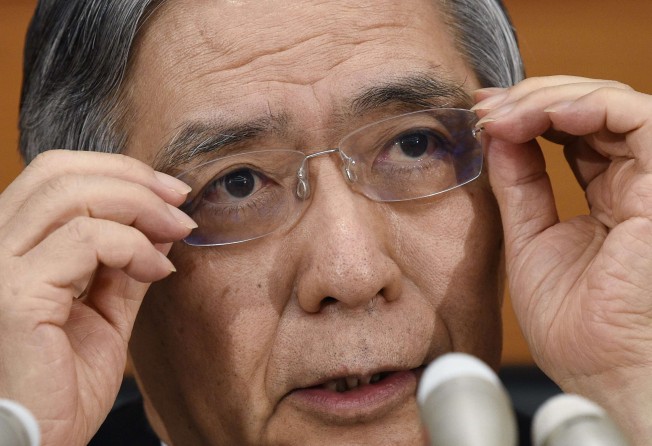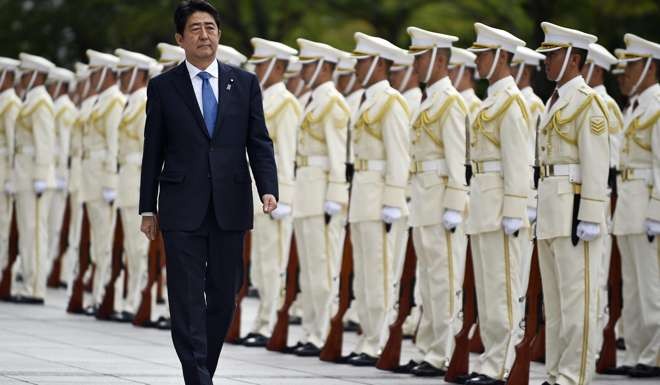Why time is running out for Japan’s economy
Dan Steinbock says a slim upward revision in GDP growth cannot mask the fact that the Bank of Japan’s ‘whatever it takes’ policy is backfiring

Recently, Japan’s second quarter GDP growth was revised upwards, to 0.7 per cent, after four consecutive quarters of stagnation. But don’t set your hopes too high.
More than three years ago, the conservative caution of Bank of Japan governor Masaaki Shirakawa faded into history as his successor, Haruhiko Kuroda, pledged to do “whatever it takes” to achieve the 2 per cent inflation target. Yet, today inflation remains close to zero and the Japanese stock market is down 13 per cent.
Irrespective of the outcome of its meeting this week, the BOJ can only postpone the inevitable.
Under Kuroda, it has boosted quantitative and qualitative easing with a negative interest rate policy. Base money and the central bank’s holdings of Japanese government bonds have each swollen to almost 400 trillion yen (HK$30.5 trillion) – 80 per cent of the country’s GDP – and they continue to expand at a pace of¥80 trillion yen annually.
If US Federal Reserve chief Janet Yellen were to do something similar, it would be economic and political suicide.
Until recently, Japan was a different story. Now, divisions are spreading in the central bank. Kuroda’s fractured majority is sticking with the original plan of large-scale government bonds and negative rates to boost growth and inflation. However, some advocate greater flexibility in purchases, hoping that would make a difference. Sceptics would like to curb the purchases, even at the risk of perceptions of tightening, a rising yen and plunging markets.
Nonetheless, all three seem to believe Japan’s fortunes can be reversed by monetary policies alone and that these policies are not part of the problem.

In 2013, the Liberal Democratic Party returned to leadership with Shinzo Abe as prime minister. The party had campaigned on renewed fiscal stimulus, aggressive monetary easing from the BOJ, structural reforms to boost competitiveness and eventual fiscal consolidation. The devaluation of the yen, critical to Japanese exporters, was the tacit denominator of the proposed changes.
In addition to a huge liquidity risk, Tokyo took another risk in timing. It sought to implement the fiscal stimulus in 2013, while fiscal consolidation would follow. Obviously, unease increased in 2014.
As Abe went ahead with the sales tax hike that spring, the recovery was too fragile for consolidation. Instead of strong expansion, Japan slid into recession and began its third lost decade.
Ironically, the yen continues to rise, thanks to stagnation in the West and the dated perception that it remains a safe-haven currency. Last summer, the International Monetary Fund finally acknowledged that Abenomics is not working.
The BOJ could not only own most of the Japanese bond market, but virtually all Japanese stocks ... It is a disastrous path
As Tokyo’s policy authorities recognised the risks, they delayed the proposed consumption tax hike, adopted new structural reforms and a negative interest rate policy.
Yet the outlook remains weak, with real GDP growth forecast at less than 1 per cent until the early 2020s. Time is running out.
If the BOJ continues to purchase government bond debt, it will own almost half by next autumn. That would leave the other half available for the BOJ to buy.
Yet, banks need some government bonds for collateral, while insurers must have long-term government bonds. So a year ago, even the IMF had to conclude that the BOJ would hit its government bond purchase ceiling “sometime in 2017 or 2018”.
Now there is the additional challenge of the flat yield curve. After the BOJ’s negative rates in January, the government bond curve has flattened drastically. Coupled with low interest rates, persistently flatter yield curves are likely to weaken financial intermediation and penalise banks, insurers and pension funds, reducing their risk-taking.
Worse, Kuroda’s monetary gamble not only involves bond markets, but equities as well. Under its stimulus plan, the BOJ bought 3 trillion yen of exchange-traded funds annually.
In spring, these purchases made it a top-10 holder in about 90 per cent of all Japanese stocks, according to Bloomberg data. In late July, the BOJ doubled its annual exchange-traded fund buys. As a result, it could become the No 1 shareholder in some 40 Nikkei 225 companies by early 2018.
In the next few years, the BOJ could not only own most of the Japanese bond market, but virtually all Japanese stocks; even as Japan’s gross debt will exceed 250 per cent of its GDP. It is a disastrous path.
Usually, political opposition can undermine failed economic policies. Yet, Japan’s main opposition Democratic Party has been struggling since it lost in 2012. In turn, Emperor Akihito has even talked of wanting to abdicate – to prevent Abe from reviving pre-war Imperial Japan, according to some analysts.

If countervailing forces linger in the domestic economy and politics, even internationally, market volatility is a different story.
Since the summer, Japan has been suffering from a bond tantrum as its sovereign debt has had its worst rout in a decade. Some expect the BOJ to pursue a reverse “operation twist ” – it could sell long-dated bonds, while buying short-term bonds to make easing more sustainable over time. But, as trillions in long-dated government bonds continue to carry negative yields, an abrupt withdrawal could roil the market.
Japan remains the world’s third-largest economy and the second-largest debt market. Moreover, correlations among major markets have increased significantly since 2008.
A perceived policy reversal could unleash a dramatic sell-off in government bonds and global fixed-income markets would not remain immune.
If that sell-off does not ensue in the autumn or in 2017-18, it will only grow into a more devastating market tsunami over time.
Dr Dan Steinbock is founder of the Difference Group and has served as the research director at the India, China, and America Institute (US) and a visiting fellow at the Shanghai Institutes for International Studies (China) and the EU Centre (Singapore). See http://www.differencegroup.net/